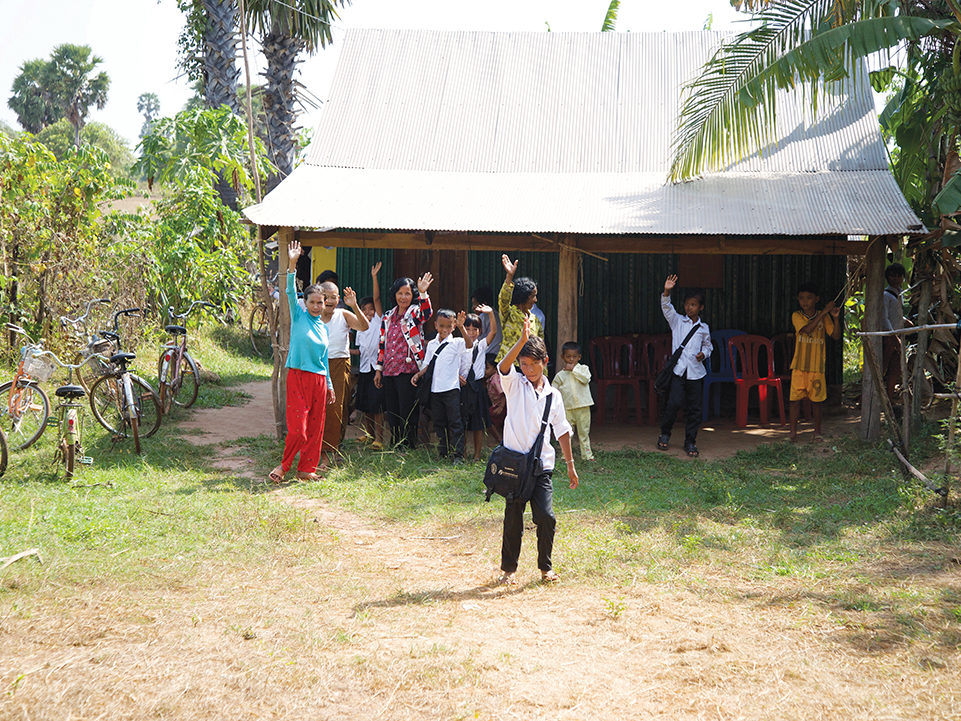In Cambodia, poverty often forces parents to migrate for work — sometimes hundreds of miles away — which puts children at greater risk of malnutrition, trafficking and exploitation. But, by supporting microloans and women’s self-help groups, Holt sponsors and donors are helping families learn sustainable agriculture skills so they can independently provide for their children, without having to travel.

At 4:30 p.m., the garment factories in southwest Cambodia are letting out for the day. Beyond the fences and gates that surround each giant, metal warehouse, a row of industrial flat-bed trucks wait, some already filling with women in bright pants and T-shirts. The two-lane road leading from the nation’s capital city, Phnom Penh, to the small fishing town of Kampot is stacked with these trucks — some with 20 or 30 passengers who sit in the back, shoulder to shoulder, their legs stretched straight. Some have more than 100 passengers, mostly women, who are packed so tightly they must stand with their stomach and back pressed into the women around them. The air is dusty as they drive, and many cover their faces with medical masks or scarves.

“When a truck wrecks, many women die,” Kosal Cheam, Holt’s director of programs in Cambodia, says grimly, shaking her head.
In Cambodia, poverty is so widespread that thousands of families are forced to migrate from rural areas to large cities like Phnom Penh or even bordering countries like Thailand to find work — often low-paying jobs in crowded garment factories. Agriculture, mainly rice production, is the dominant economic driver in the region and many families survive on what they grow. But drought is a common occurrence. And when nothing grows, many families are out of work.
In February, temperatures hover around 95 and rice fields are dry, brown and dusty.

“No rain,” Kosal says, en-route from Phnom Penh to Holt’s programs in rural Prey Veng. “There hasn’t been rain in a long time. Nothing grows when it’s this dry.”
This is alarming news.
When nothing grows, there is less to eat. Families butcher their chickens or ducks, if they’re lucky enough to own them, or dig deeper into their supplies of rice. However, very few families have sufficient land to grow enough rice for the entire year. If they eat beyond their rations now, they will just be even hungrier later in the summer.
The harvest usually starts in November. Already, many NGOs in the region are preparing for potential water and food shortage emergencies in Cambodia.
The harvest usually starts in November. Already, many NGOs in the region are preparing for potential water and food shortage emergencies in Cambodia.
In these circumstances, parents are faced with hard decisions. Do they stay home with their children and do the best they can to raise and grow their own food despite water shortages? Or, do they migrate to Phnom Penh or an area with garment factories to look for steady work?
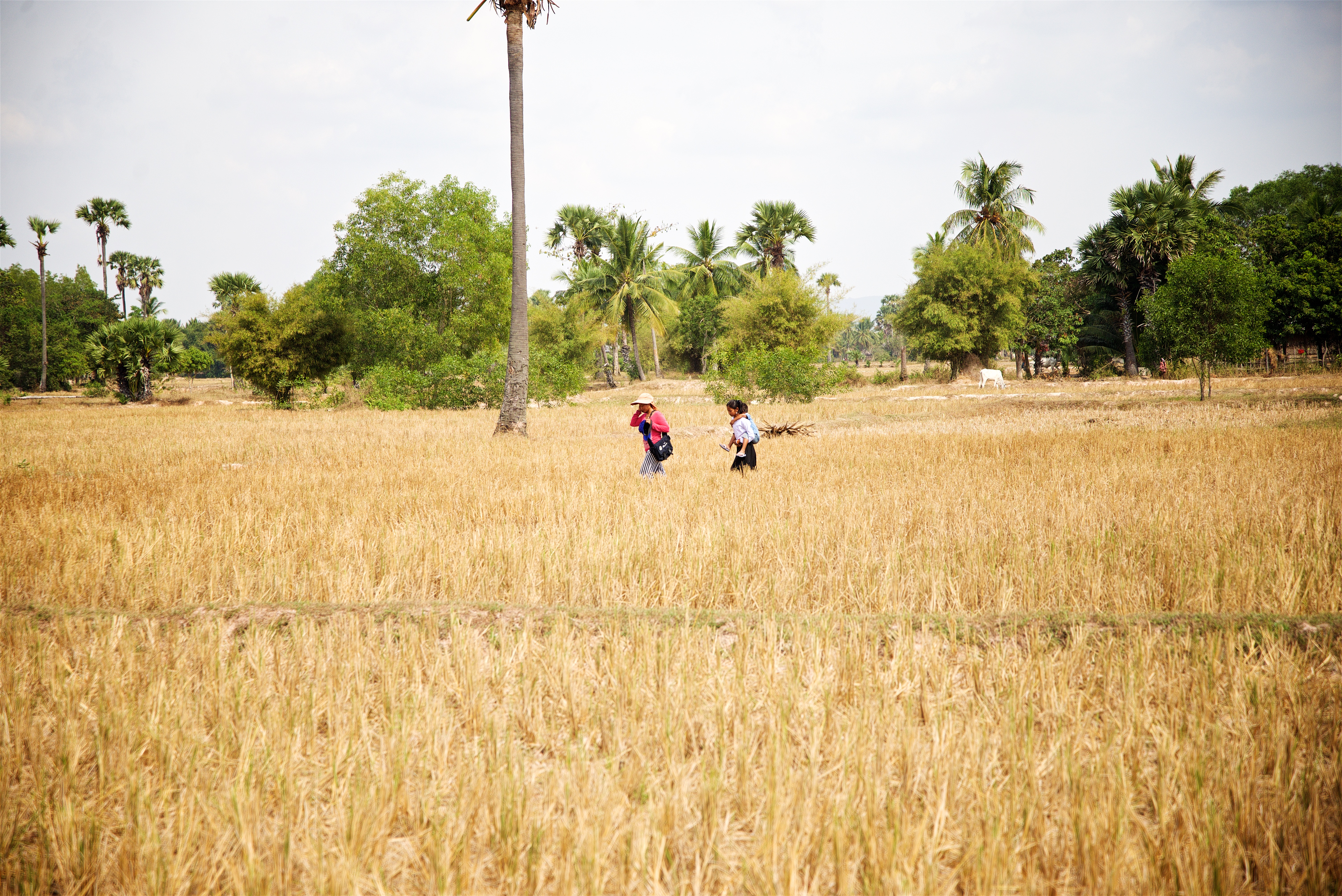
There are no easy answers.
These decisions are especially difficult if a child falls ill and parents can’t afford medical care, or if their rice yield was less than expected and the family already faces hunger and malnutrition. On the other hand, if one or both parents migrate to find better work, their children will stay with grandparents or other family and may be vulnerable to neglect, abuse or exploitation. They may fall behind in school without a parent’s watchful eye. When children grow up without their families, the result can be catastrophic.
Yai, a 34-year-old mother of two, understands this struggle well.

Yai lives in a one-room wooden house built on stilts with her husband, a 13-year-old son and 9-year-old daughter in Trepang Sre Village in Prey Veng Province, an area between Phnom Penh and the Vietnam border. They store their drinking, bathing and cooking water in a 20-gallon ceramic pot. They cook over an outdoor brick-and-wood-fired stove, which they built themselves, and they sleep together on mats under one mosquito net, which hangs from the tin roof of their home. The bulk of the family’s possessions consist of a few outfits of clothing each, a couple of blankets, some pots and cooking dishes and a few plastic bins. They store their annual supply of rice in a four-foot-tall woven basket, which beside their sleeping space and few possessions is the only thing inside their home.

Yai’s husband might make $5 per day working construction, but the work often takes him far from home and it isn’t steady. Through the years, Yai and her husband have often struggled to produce enough food to ensure they have enough to eat all year, and their income wasn’t enough to pay for their children’s school materials. The cost of books, pens, uniforms and backpacks can be $20 or more per term — an out-of-reach amount for many families in Prey Veng.
Until last year, when Holt began serving vulnerable children and families in this region, Yai migrated to work at a garment factory to help meet the most basic needs to her family — most importantly, keeping her children in school. Her children stayed with their grandparents nearby.
“Being away, I missed my children,” Yai says. “Even though they were with family, they weren’t with their mom and dad.”

Garment production is booming in Cambodia.
Nearly 80 percent of Cambodia’s exports are textiles — shoes, clothes, plush toys. And of the 300,000-500,000 people who work in garment factories, 91 percent are women. Garment factories dot the countryside, especially southwest of Phnom Penh’s city center, where land is cheaper. Some factories are large — huge, sprawling tin buildings with giant, industrial fans swirling overhead. Some are built campus-style, where many factories occupy the same fenced-in space, with security controlling traffic through a front gate.
Garment factories, while often a symbol of corporate greed and mindless consumption in the U.S., are relatively well received in Cambodia.
“Those are good paying jobs,” Kosal says simply.

Minimum wage standards dictate that garment factory employees should earn at least $139 per month, but it’s likely that many are paid less. Still, in comparison to the monthly income expected from farming, making more than $100 per month is considerable. Many subsistence farmers live on less than half that amount and struggle to survive on incomes of $30-60 per month.
For Yai, working in the factories meant she missed her children, her husband and her village constantly. The work was hard and tiring, and after all the costs associated with living far from home, she wasn’t making that much more money. But economic opportunities at home were scarce, and she didn’t have any skills.
It’s families like Yai’s that prompted Holt to start programs in the region in 2013 — addressing issues of financial instability, and the myriad ways poverty impacts the security of children, including the possibility of child abandonment or exploitation.
It’s families like Yai’s that prompted Holt to start programs in the region in 2013 — addressing issues of financial instability, and the myriad ways poverty impacts the security of children, including the possibility of child abandonment or exploitation.
Too many Cambodian children, we learned, were living outside or without their family due to migration. At best, children would fall behind in their education. At worst, children living apart from their families were vulnerable to abuse, hunger, child labor or trafficking.

To keep children with their families, in school and safe, Holt needed to help parents generate income, and help women, in particular, earn better income. Our on-the-ground partners from Children and Life Association (CLA), a non-profit group working to end child abuse and exploitation in the province, identified 90 of the most vulnerable families and 200 children from six villages in Prey Veng to begin receiving support through child sponsorship in 2015. To help generate income, Holt and CLA worked with these villages to form women’s self-help groups, where mothers or grandmothers enrolled in Holt’s programs meet monthly to discuss common problems, encourage one another, begin a community savings and loan fund and learn income-generating skills, such as raising livestock. Holt donors provided the funds so families could begin taking low-interest loans to purchase farm animals for income or to cover medical expenses or pay off high-interest debt to loan sharks. On a community level, Holt and CLA organized peer-led education groups, where older students help teach younger children about children’s rights, how to spot and report abuse, and how to identify a scam intended to coerce a child into being trafficked. Sponsored children also receive additional educational support.
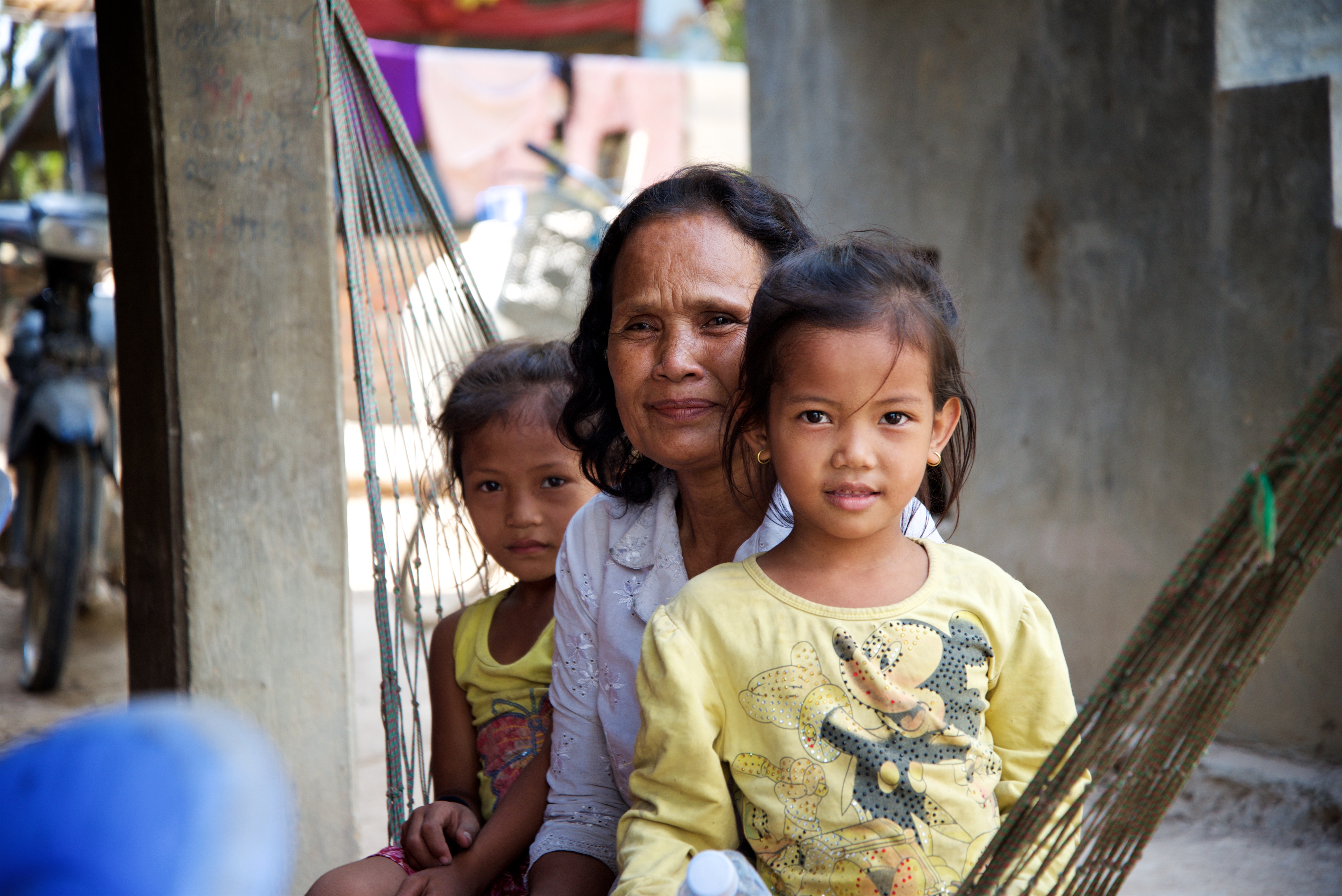
For Yai, Holt’s work in the region offered a chance to stay home with her children — and learn valuable skills from other mothers in her community.
The road to Yai’s village starts wide and smooth, but gradually turns to a narrow, dusty single lane marked by bumps and potholes. Children in school uniforms travel along the side of the road in small packs. Women rest in the shady space under their homes, waiting for the heat to dissipate before they return to work. This area is one of the poorest districts in Cambodia, and nearly 15 percent of families don’t own any land, even though everyone in the community relies almost exclusively on land to generate income — whether working their own plots, or plots owned by others. Malnutrition and hunger-related illness is common here, so besides teaching and investing in family-based sustainable agriculture, CLA also teaches children and families about sanitation and hygiene and how to ensure children receive proper nutrition.

Yai’s home is about a quarter of a mile off the main road, just across from the village chief’s home where the 33 women involved in the women’s self-help group meet monthly to share information and wisdom about raising children, farming practices and saving money. The women also have the opportunity to attend special training courses to improve their skills or better care for their children. And, thanks to those new skills, Yai’s house has a few new elements. An array of bamboo and thatch cages surrounded by rough chain-link and chicken wire fences provide safety to one of the family’s greatest assets — their bank account, by all measures — of 18 hens, lots of baby chickens and about 20 ducks. She purchased her first hens and ducks with money she borrowed from the Holt-supported women’s self-help group, and CLA staff helped teach her how to raise them. Yai and her husband also have a small, man-made pond where they keep live fish, as well as a small vegetable garden, both of which provide additional food for their children.
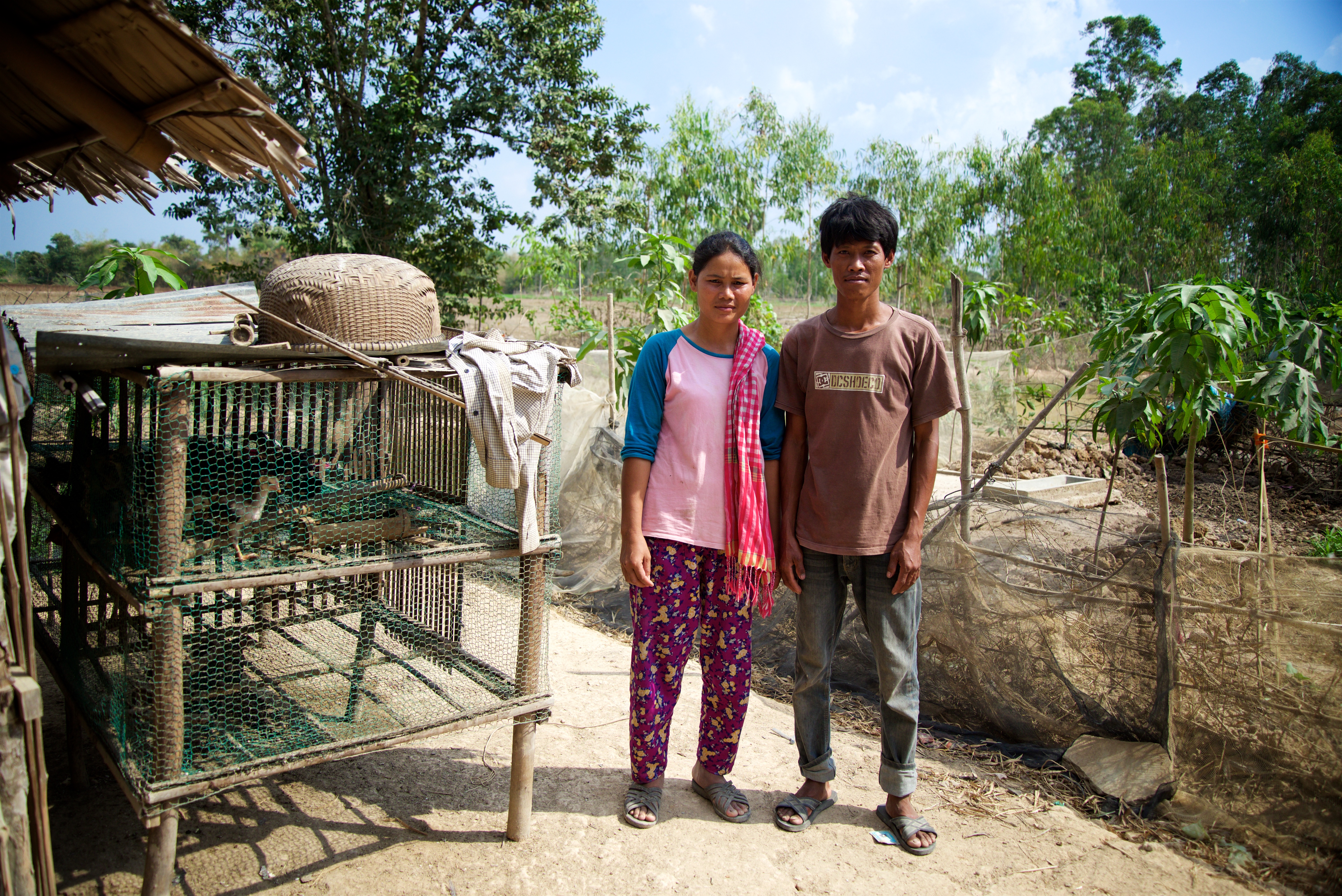
Yai can sell full-grown chickens for about $5-7 each, making a total of around $50 per month. And she can generate similar income from ducks. This is a considerable income boost for her family, especially for this area.
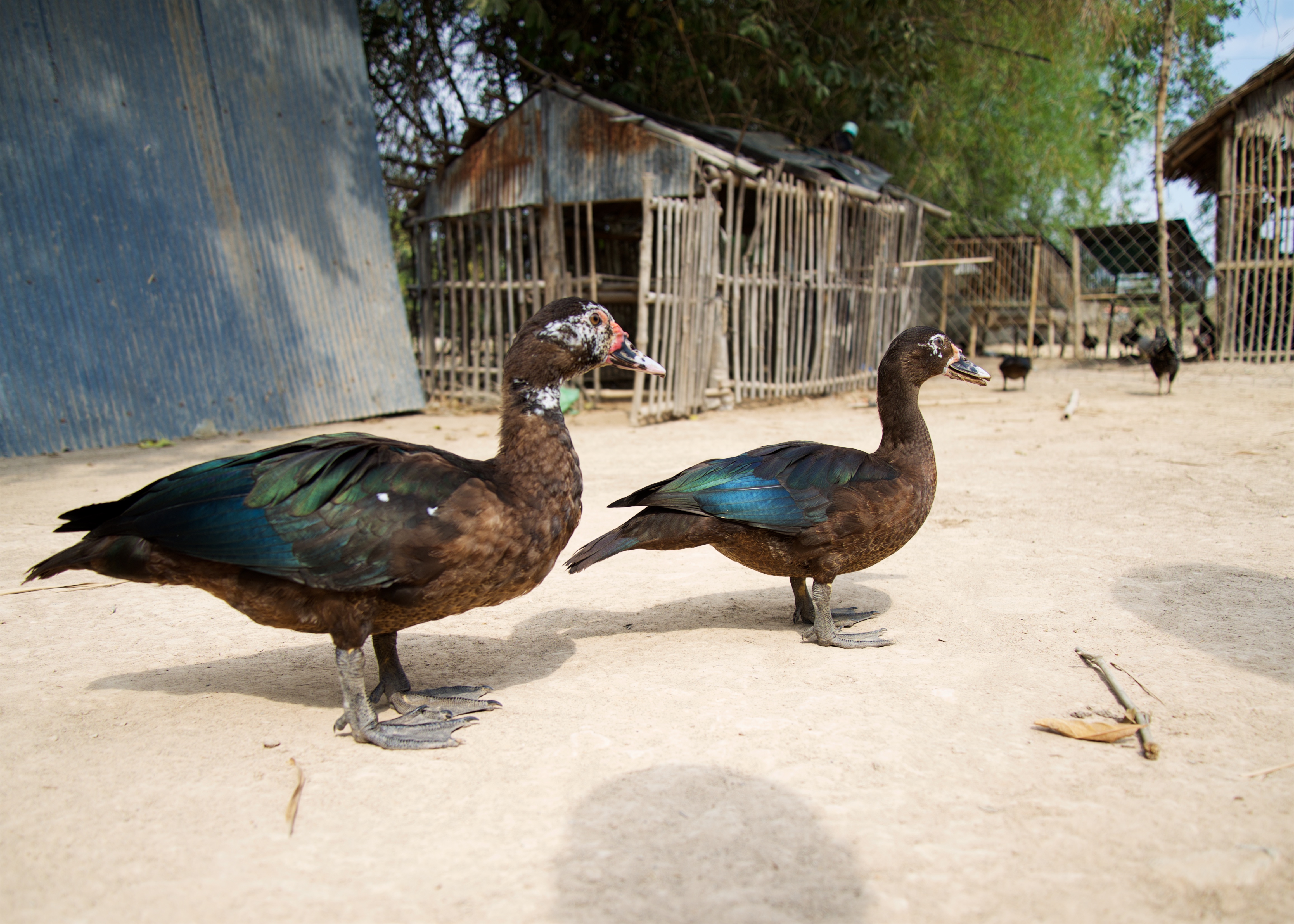
One of CLA’s two community development officers who works with Holt-sponsored families is Loan Leang, who grew up in a farming family in this same area. After high school, he received training from Veterinarians Without Borders, learning practical skills to improve animal raising in Cambodian villages. Now, he teaches women how to vaccinate their own baby chicks, or provide basic medical care to pigs and cows. By empowering families with the skills to care for their animals, Loan provides an invaluable service to poor families — one that helps them avoid the financial hardship caused when an animal dies.

Just down the road from Yai lives Pelly and her family. With four children to care for and feed, Pelly used to travel to Thailand to work, making just a few dollars a day tilling and harvesting fields for other farmers or doing manual labor. Her husband makes about $7 per day working construction, but he often travels for work, too.
While Pelly was away for work, sometimes eight months out of the year or more, her children lived with their grandparents, but their education suffered.
“My second grader is a year behind in school,” Pelly says in Khmer. “She missed a lot while I was away in Thailand. She sometimes is still angry that she’s behind.”

In 2015, Pelly joined the same Holt-funded women’s group as Yai, and she was able to take out a $100 loan to purchase a pig. With education and assistance from CLA, she learned about raising and selling pigs, and when her pig had 10 babies, she was able to sell each one for $20 within about a month of being born. With the $200 profit, she began repaying her loan — and has been able to continue repaying in small increments. The full balance will be paid off in May, and then Pelly can borrow again if she chooses. Pelly and her husband have also been able to make some repairs to their one-room home, adding tin instead of thatch to keep the family safe during the rainy months. She has a small flock of ducks and some hens, too.
Pelly also kept one piglet for her family after her first litter, which has grown considerably in size. On this hot day, he’s rolling in his muddy pen, turning his black spots brown. Neighbor children stick their hands into his pen and the pig oinks and scrunches his nose in disappointment at their empty palms. Recently, the first pig she purchased had another eight piglets, and they will soon be old enough to sell.
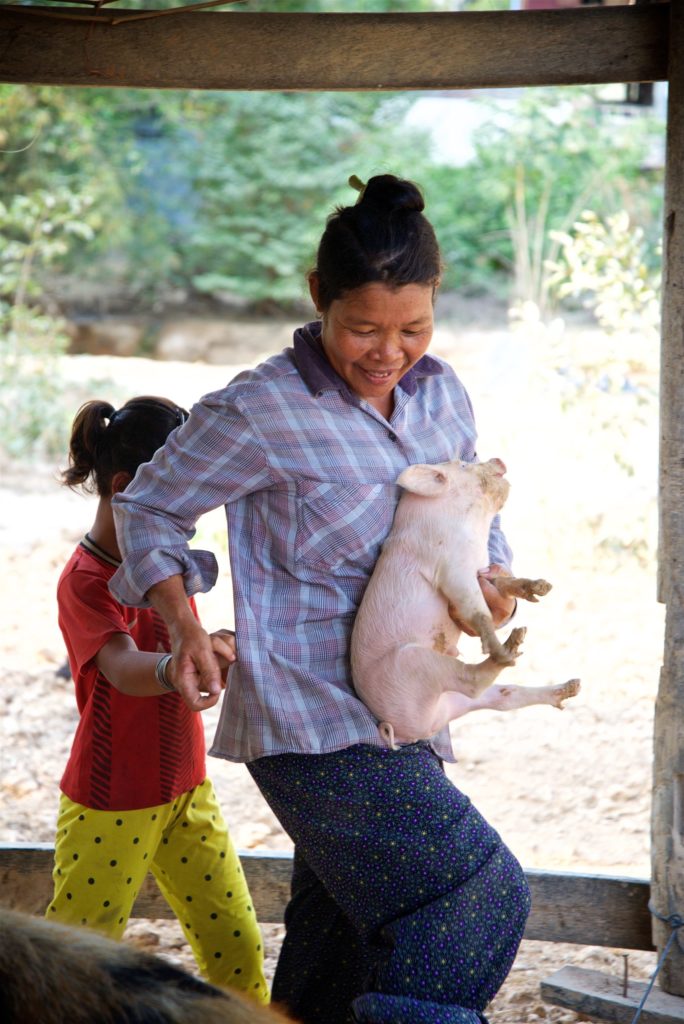
For Pelly, these little piglets make her feel proud.
As Pelly has expanded her farm, the money she makes raising animals and growing crops is enough that she and her husband can support their children without Pelly migrating for work. All four children are in school with support from their Holt sponsors, and they are happy to have their mother at home. The family is moving closer and closer to self-reliance. Eventually, they will be stable enough to provide for their children without any support from Holt or CLA.
“Before, women and children were hopeless about the future. But now, they are learning to have hope. Parents and children know that’s important.”
Buth Saman, director of Holt partner Child and Life Association
Pelly was only able to attend primary school as a child, but she has big dreams for her children — dreams that are only possible if they stay in school.

“I want one child to be a doctor and another to be a teacher, at least,” she says.
Small loan programs like the one Yai and Pelly have benefited from typically take about five years to show their full impact. However, the fact that self-help groups and microloans are providing immediate reunification of families and preventing migration within just a year is tremendously promising for the future.
“Before, women and children were hopeless about the future,” says CLA’s director, Buth Saman. “But now, they are learning to have hope. Parents and children know that’s important.”
Written by Billie Loewen | Former Holt Team Member

Give a Gift of Hope
Give a lifesaving or life-changing tangible gift to a child or family in need. And this holiday season, give in honor of a loved one and they’ll receive a free card!



